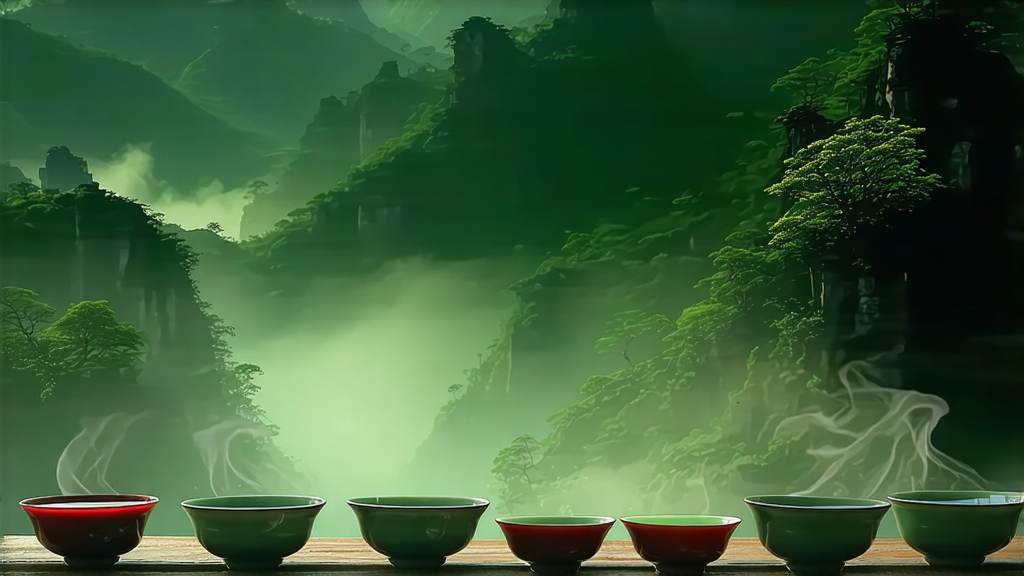
High above the Nine-Bend Stream of northern Fujian, the Wuyi Mountains rise like a procession of stone giants wrapped in perpetual cloud. Their vertical cliffs, eroded into crevices no wider than a monk’s sleeve, cradle the most mythic of all oolongs—Da Hong Pao, literally “Big Red Robe.” To Chinese tea lovers the name alone evokes reverence; to newcomers it sounds like a martial-arts epic. Yet the story, the leaf, and the liquor are all real, and they reward the patient drinker with a spectrum of flavors that oscillate between roasted nuts, dark honey, wet stone, and orchid perfume.
Legend sets the origin in the Ming dynasty. A scholarly court official traveling to the capital fell gravely ill at the foot of Wuyi’s Tianxin Rock. Monks from the nearby Yongle Temple brewed leaves picked from four stunted bushes clinging to the cliff. The scholar recovered, continued to Beijing, and presented the remaining tea to the emperor. Grateful, the monarch sent crimson silk robes to drape the mother trees, declaring them imperial property. Whether or not the tale is embroidery, the four original bushes still stand—now 350 years old, fenced off and guarded like living relics. In 2006 the Chinese government forbade further picking from them; the last 20 g of their leaf sold at auction for over US $30,000, making Da Hong Pao the most expensive tea ever measured by weight.
Fortunately, “true” Da Hong Pao did not disappear. Wuyi horticulturists long ago took cuttings from the mother trees and grafted them onto seedling rootstocks in the same rocky micro-terroir. These asexually propagated clones, called que wei (pure taste), grow on narrow ledges between 300–600 m elevation where the granite reflects heat and the Danxia sandstone holds just enough moisture. The mineral-starved soil forces the roots to mine deep, concentrating aromatic compounds. Locals speak of yan yun—literally “rock rhyme”—a tactile finish like licking a wet stone that vibrates in the throat long after swallowing. No other oolong, not even the celebrated Anxi Tie Guan Yin, can replicate this terroir signature.
Processing Da Hong Pao is a choreography of timing and fire. Picking occurs only in late April, when three half-mature leaves and a bud form the classic “fish-tail” pluck. The first step, wilting, is done outdoors on bamboo trays set in the shade of the very cliffs that gave the leaf its character. Night chill and mountain breeze reduce moisture to 65 % within two hours. Indoors, the tea is bruised in rotating bamboo drums to initiate oxidation at the edges while the leaf center stays green. Oxidation is arrested at 40 %—the midpoint between green and black—by a 280 °C tumble in electric woks. What follows is the craft that separates Wuyi masters from novices: charcoal roasting. Using local hardwoods, the tea is baked in shallow bamboo baskets nested in ash-covered embers for 6–10 hours, rested for a week, then roasted again; premium grades receive three cycles. The goal is to drive out “grassy” moisture while caramelizing sugars without masking yan yun. A well-roasted Da Hong Pao can age for decades, its fire mellowing into dried longan and sandalwood.
Brewing the leaf demands the gongfu mindset: small vessels, many short steeps, and attention that borders on meditation. A 120 ml gaiwan or Yixing zisha teapot seasoned only with rock oolongs is ideal. Use 6 g of leaf—about two heaping tablespoons—rinsed for three seconds to wake the twisted stripes. The first proper infusion, 10 s at 98 °C, yields a pale apricot liquor that smells of burnt sugar and iris. Cups should be thimble-sized, allowing the drinker to sip while the liquor is still hot enough to volatilize aromatics. By the third steep the color deepens to amber; roasted notes recede, revealing nectarine and a metallic minerality that sparks salivation. Aroma cups—tall, slender porcelain cylinders—trap the rising vapor; after emptying, lift the cup to your nose and inhale slowly to catch the “empty cup fragrance,” a honey-lilac echo that can persist for minutes. Good leaf delivers 8–